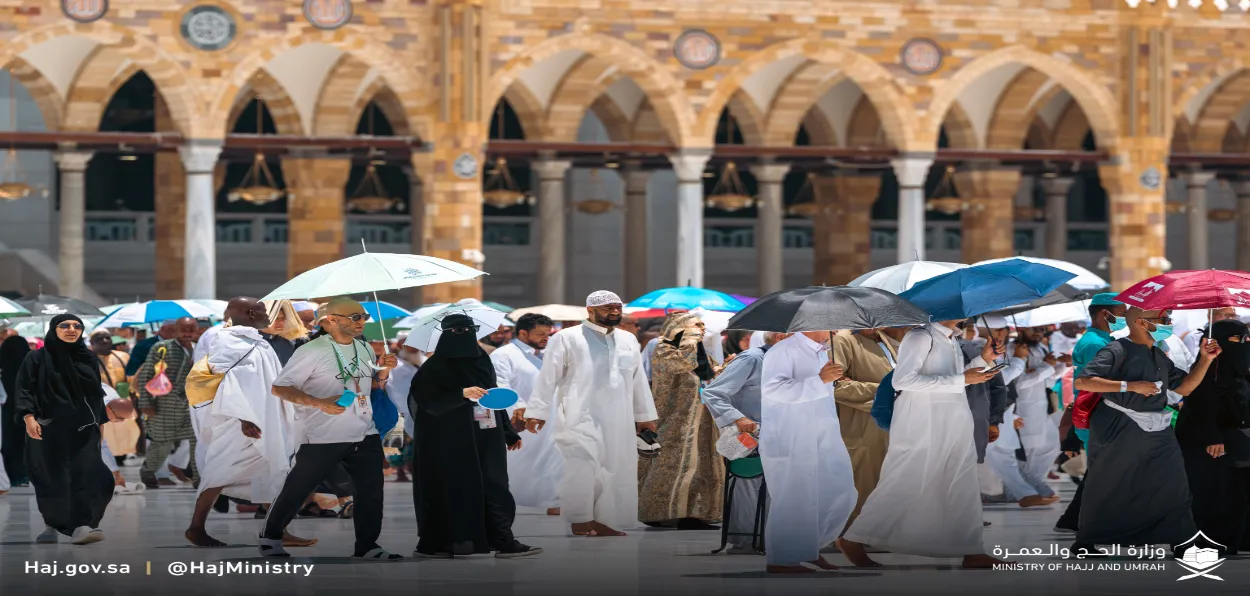
New Delhi
The annual pilgrimage of Hajj has come to an end with 18 lakh pilgrims performing this mandatory duty as followers of Islam. Despite the best arrangements by Saudi Arabia's government, due to extreme heat 1300 pilgrims have died in this season.
However there is grim prediction for the Saudi Arabian regime as far as the management of this annual pilgrimage is concerned and the revenue from which and the Umrah make up for 7.0 percent of the Kingdom's GDP.
According to Future Market Insights (FMI), the Hajj and Umrah tourism market was expected to fetch revenue of US$ 150 billion in 2022 and is likely to cross US$ 350 billion in 2032. Not only Kingdom of Saudi Arabia but other countries sending pilgrims are also getting the benefit due to the related economic activities, especially travel, aviation and hospitality industry.
An Indian pilgrim in devotion during Hajj
As per the Middle East Institute in Washington, climate change has caused average summer temperatures in the oil-rich sub-continent to rise by 2.5 degrees Celsius over the past four decades. According to Washington Post and the nonprofit organization Carbon Plan, by 2050 Mecca will have 182 days of dangerously hot weather for those out in the sun. It estimates that there would be 54 days when the heat would be dangerous for humans even when they are standing in the shade.
This year, most of the pilgrims who died were from Egypt while 58 were from India. Likewise, in 1985 when there was a heatwave in Saudi Arabia during the pilgrimage, saw the death of more than 1,000 people.In this era of social media, news of deaths spread faster and so did opinions and reactions on the reasons behind these. Many netizens criticised the Saudi government for the poor arrangements for the pilgrims.
The government of Saudi Arabia confirmed the death of 1300 people in the last five days of Hajj. It explained that the majority of the dead were elderly people who had joined the pilgrimage without due registration. They did not come on a Hajj visa but on a visit visa. Also, they were solo pilgrims without any support or being members of a group.
The embassies of many countries have confirmed this. Most of such unregistered tourists came to Saudi several months before the Hajj began. They performed Hajj without proper accommodation, food, and transport facilities that are available for all those who come on Hajj Visa.
A poster with instructions issued by the Ministry of Hajj and Umrah for pilgrims
Tunisia has confirmed that most of its citizens who died during Hajj had arrived in Saudi Arabia on tourism, umrah, and visit visas. Similarly, not all of the dead or missing Jordanian pilgrims were part of their country's official Hajj delegation - they entered Saudi Arabia on tourist and visit visas and without Hajj permits.
However, the most common reason for pilgrims dying or feeling sick was that they took the instruction about not leaving their tented accommodation or rooms between 11 am and 4 pm casually. Probably, due to sheer excitement, curiosity or to "seek more divine blessings", the pilgrims stepped out and had to pay a heavy price.
Had the pilgrims not ignored the instructions, the number of casualties might be less. An important aspect of the tragedy is that most of the dead were elderly people over the age of 60. The Hajj Committee of India had made it mandatory for the pilgrims over the age of 70 years to be accompanied by a person.
However, thousands of elderly people from other countries came alone. Experts say that the Hajj is only mandatory provided one is a person of means and enjoys good health. However, the reality is that many people choose to perform Hajj in advanced years after discharging their worly responsibilities and saving money for the pilgrimage.
Pilgrims become emotional as they are ready to leave Saudi Arabian soil after completing the Hajj
With constant increase in the number of pilgrims, Hajj is a challenge for the authorities. The government of Saudi Arabia had deployed more than 32,000 health workers to deal with cases of heat stroke and other health emergencies. Free water bottles were distributed while the policemen and volunteers were spraying water on pilgrims to protect them from the heat.
However, experts say that spraying water is effective in preventing heat stroke when the atmospheric temperature is below 35 degrees Celsius.Saudi Arabia has done elaborate arrangements to deal with extreme heat. This included the providing more than one lakh air-conditioned tents, free distribution of water and umbrellas, water sprinklers, etc.
However, at places like Maidana, Mount Arafat, and Mani, the pilgrims have to walk and halt under open skies.
ALSO READ: Hajj Committee CEO Liaquat Ali Afaqi reveals how inclusive machinery of Indians works for pilgrimage
Liaqat Ali Afaqi, CEO of the Hajj Committee of India, had said that this time, ambulances from other countries were not allowed to go to Arafat and Mani. Because of this, the sick pilgrims had to run around for help. Also, to avoid congestion on the route, the authorities made a diversion making pilgrims walk several kilometers extra.
.
